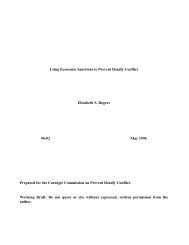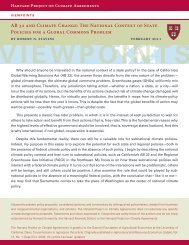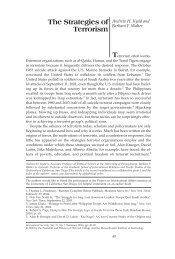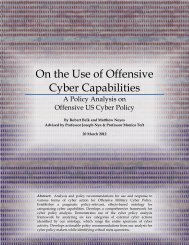Plutonium Mountain - Belfer Center for Science and International ...
Plutonium Mountain - Belfer Center for Science and International ...
Plutonium Mountain - Belfer Center for Science and International ...
- No tags were found...
You also want an ePaper? Increase the reach of your titles
YUMPU automatically turns print PDFs into web optimized ePapers that Google loves.
Chronology of Degelen <strong>Mountain</strong> Cleanup<br />
1949: The first nuclear test conducted by the Soviet Union detonates at Semipalatinsk.<br />
Testing continued until 1991. There were 456 tests in total.<br />
1991: The Soviet Union collapses <strong>and</strong> Kazakhstan becomes an independent state.<br />
1991-2009: Local scavengers <strong>for</strong>age the testing site. They strip copper wiring <strong>and</strong> steel<br />
rails to sell as scrap metal. Access is unfettered in the 1990s. With U.S. <strong>and</strong> Russian threat<br />
reduction work in the 2000s, scavenging diminishes, but continues periodically during<br />
periods of inactivity at the site. In 2009, Kazakhstan adopts a law making sensitive portions<br />
of the testing site an “exclusion zone.” Signs <strong>and</strong> security systems are put in place.<br />
1993: The U.S. signs a $6 million program to close portals to testing tunnels at Degelen<br />
<strong>Mountain</strong>. Called the Degelen <strong>Mountain</strong> Tunnel Neutralization Project, the operation is<br />
designed to destroy the infrastructure so testing could never be resumed. It is not targeted<br />
at preventing scavenging or theft of nuclear material. About 181 holes were closed.<br />
1994: The U.S. airlifts about 605 kg (1332 pounds) of highly-enriched uranium from<br />
Kazakhstan in “Project Sapphire.”<br />
1995: A team of scientists from Los Alamos National Laboratory (LANL) visits Semipalatinsk.<br />
1995: A LANL official, Danny Stillman, drafts a memo, “Project Amber: Elimination of a<br />
Potential Source of Special Nuclear Materials.” The memo warns that unsecured nuclear<br />
bomb fuel exists in the tunnels at Degelen <strong>Mountain</strong> <strong>and</strong> the complex could become a<br />
“plutonium mine.”<br />
1998: A delegation of Kazakh scientists from Semipalatinsk visit Los Alamos National<br />
Laboratory. They warn the recently-retired head of LANL, Sig Hecker, that scavengers are<br />
scouring Degelen <strong>Mountain</strong>.<br />
1998 (April): Hecker visits Semipalatinsk <strong>and</strong> takes photographs of the scavenging activity.<br />
1998 (July): Hecker travels to the two main Russian nuclear weapons laboratories,<br />
Arzamas-16 <strong>and</strong> Chelyabinsk-70. In meetings with the lab directors, Hecker presents<br />
evidence of scavenging at Degelen <strong>Mountain</strong> <strong>and</strong> implores Russia to take action. Radi Ilkaev,<br />
the director of Arzamas-16, is initially reluctant, but then offers support.<br />
1999 (June): Hecker <strong>and</strong> Ilkaev meet at a NATO-sponsored conference in Almaty, Kazakhstan.<br />
Also at the meeting is a senior Kazakh scientist, Kairat Kadyrzhanov. On the margins of the<br />
conference, Hecker, Ilkaev <strong>and</strong> Kadyrzhanov sign a three-way agreement <strong>for</strong> a series of field<br />
studies that would scope out the size of the problem at Semipalatinsk<br />
2000: Several meetings take place between the three countries to agree on implementation.<br />
The most prominent occurs in May when Rose Gottemoeller, then assistant secretary of<br />
Energy, meets Lev Ryabev, Russia’s first deputy minister <strong>for</strong> atomic energy.<br />
22<br />
<strong>Plutonium</strong> <strong>Mountain</strong>: Inside the 17-year mission to secure a dangerous legacy of Soviet nuclear testing














